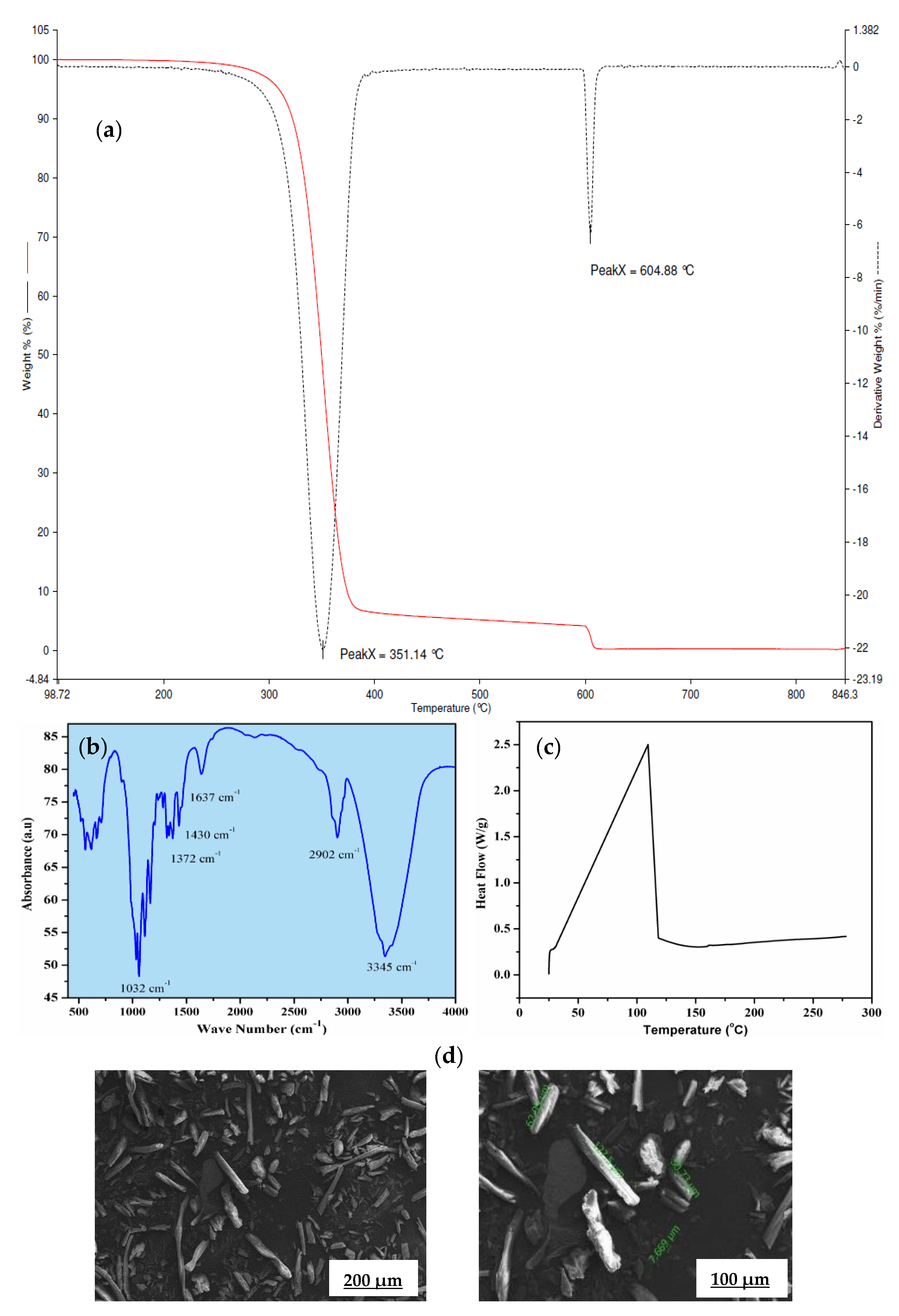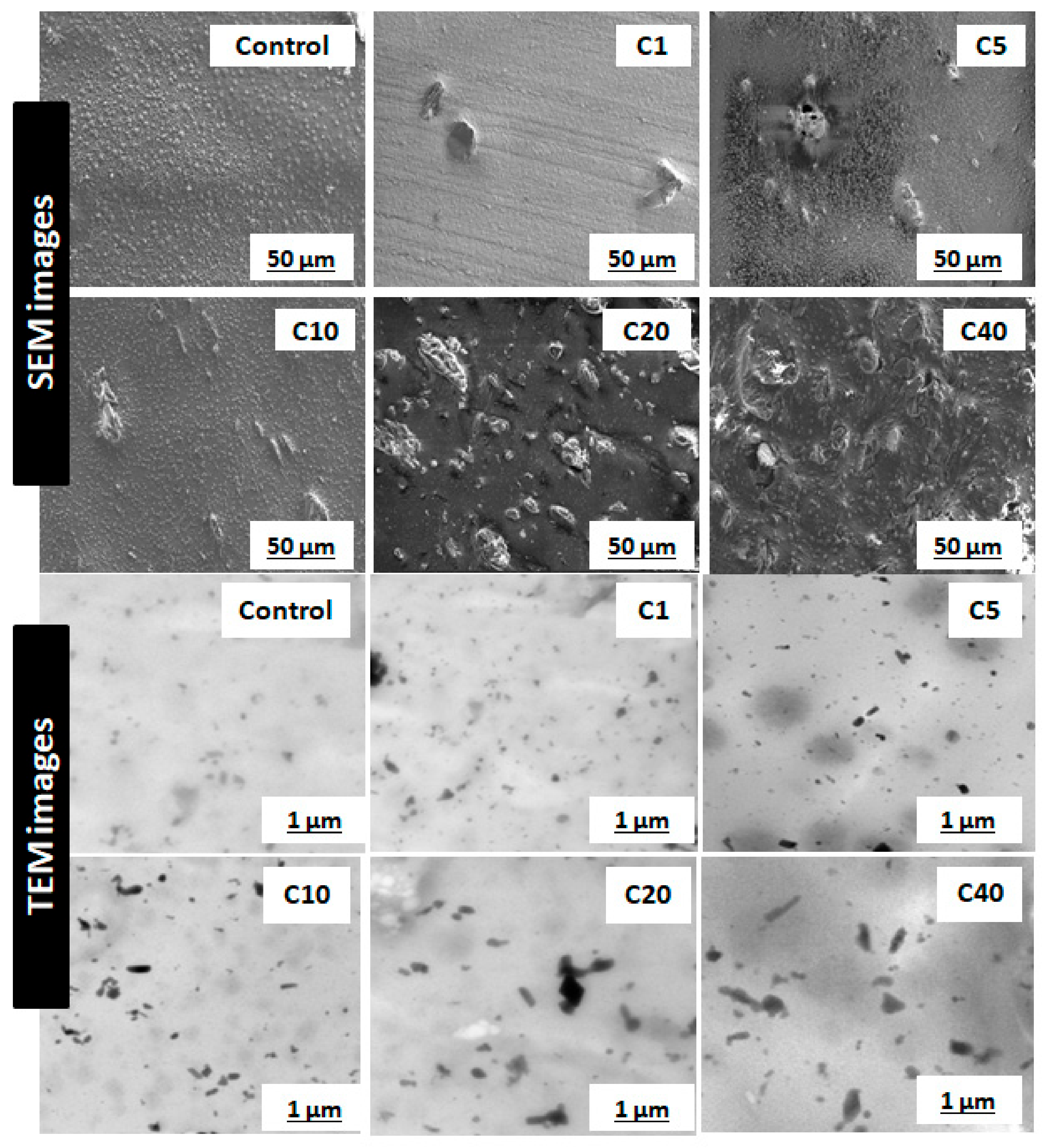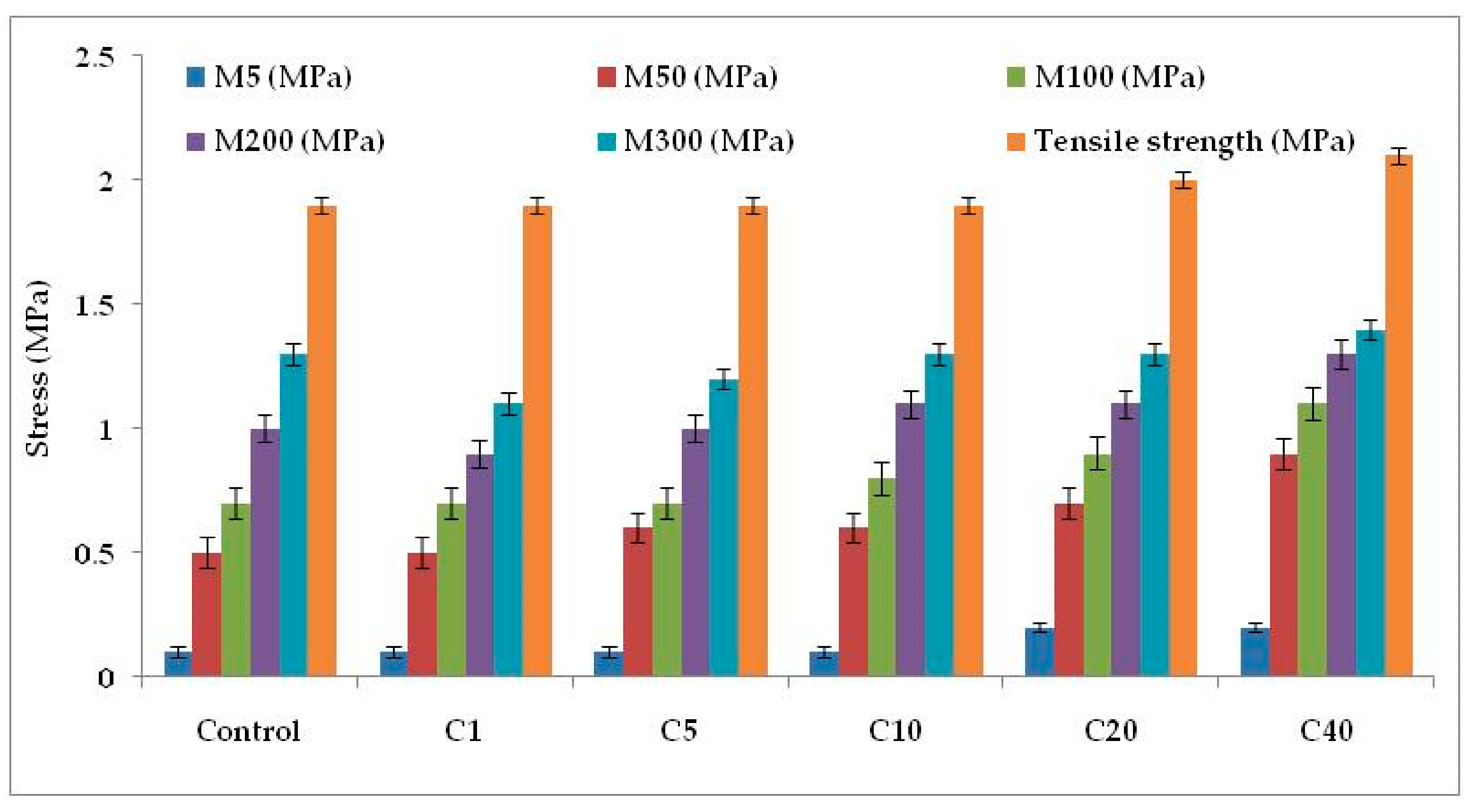Morphology and Physico-Mechanical Threshold of α-Cellulose as Filler in an E-SBR Composite
Abstract
:1. Introduction
2. Results and Discussion
2.1. Characterization of α-Cellulose
2.2. Characterization of E-SBR-α-Cellulose Composites
2.2.1. Investigation on Morphological Threshold
2.2.2. Filler Dispersion and Filler Networking
2.2.3. Vulcametric Characterization of the Composites
2.2.4. Physico-Mechanical and Dynamic Mechanical Characterization of the Compounds
2.2.5. Rubber–Filler Interaction
3. Materials and Methods
3.1. Chemicals
3.2. Characterization of α-Cellulose
3.2.1. SEM Topography
3.2.2. TEM Imaging
3.3. Preparation of Composites
3.4. Measurement of Payne Effect
3.5. Determination of Cured Characteristic
3.6. Preparation of Molded Slabs and Measurement of Physico-Mechanical Properties
3.7. Measurement of Dynamic Mechanical Properties
3.8. Measurement of Rubber-Filler Interaction
4. Conclusions
Author Contributions
Funding
Institutional Review Board Statement
Informed Consent Statement
Data Availability Statement
Acknowledgments
Conflicts of Interest
Sample Availability
References
- Otegui, J.; Miccio, L.A.; Arbe, A.; Schwartz, G.A.; Meyer, M.; Westermann, S. Determination of filler structure in silica-filled SBR compounds by means of SAXS and AFM. Rubber Chem. Technol. 2015, 88, 690–710. [Google Scholar] [CrossRef] [Green Version]
- Thaptong, P.; Sae-Oui, P.; Sirisinha, C. Influences of styrene butadiene rubber and silica types on performance of passenger car radial tire tread. Rubber Chem. Technol. 2017, 90, 699–713. [Google Scholar] [CrossRef]
- Encyclopedia, V.N.S. Styrene-Butadiene Rubber; John Wiley & Sons, Inc.: New York, NY, USA, 2007. [Google Scholar]
- Yadollahi, S.; Ramezani, M.; Razzaghi-Kashani, M.; Bahramian, A.R. Nonlinear viscoelastic dissipation in vulcanizates containing carbon black and silanized silica hybrid fillers. Rubber Chem. Technol. 2018, 91, 537–547. [Google Scholar] [CrossRef]
- Wang, M.J.; Zhang, P.; Mahmud, K. Carbon-silica dual phase filler, a new generation reinforcing agent for rubber: Part IX. Application to truck tire tread compound. Rubber Chem. Technol. 2001, 74, 124–137. [Google Scholar] [CrossRef]
- Feng, W.; Tang, Z.; Weng, P.; Guo, B. Correlation of filler networking with reinforcement and dynamic properties of SSBR/carbon black/silica composites. Rubber Chem. Technol. 2015, 88, 676–689. [Google Scholar] [CrossRef]
- Lin, C.J.; Hergenrother, W.L.; Alexanian, E.; Böhm, G.G.A. On the filler flocculation in silica-filled rubbers part I. Quantifying and tracking the filler flocculation and polymer-filler interactions in the unvulcanized rubber compounds. Rubber Chem. Technol. 2002, 75, 865–890. [Google Scholar] [CrossRef]
- Wang, D.; Ren, F.; Zhu, C.; Feng, J.; Cheng, Q.; Chen, S.; Shen, G.; Wang, F. Hybrid silane technology in silica-reinforced tread compound. Rubber Chem. Technol. 2019, 92, 310–325. [Google Scholar] [CrossRef]
- Chowdhury, S.G.; Chanda, J.; Ghosh, S.; Banerjee, K.; Banerjee, S.S.; Das, A.; Ghosh, P.; Bhattacharyya, S.K.; Mukhopadhyay, R. Impact of adhesive ingredients on adhesion between rubber and brass-plated steel wire in tire. Polym. Eng. Sci. 2020, 60, 1973–1983. [Google Scholar] [CrossRef]
- Ten Brinke, J.W.; Van Swaaij, P.J.; Reuvekamp, L.A.E.M.; Noordermeer, J.W.M. The influence of silane sulfur and carbon rank on processing of a silica reinforced tire tread compound. Rubber Chem. Technol. 2003, 76, 12–35. [Google Scholar] [CrossRef]
- Chigondo, F.; Shoko, P.; Nyamunda, B.C.; Moyo, M. Maize Stalk As Reinforcement in Natural Rubber Composites. Maize Stalk Reinf. Nat. Rubber Compos. 2013, 2, 263–271. [Google Scholar]
- Nordin, R.; Said, C.M.S.; Ismail, H. Properties of rice husk powder/natural rubber composite. Solid State Sci. Technol. 2007, 15, 15–16. [Google Scholar]
- Hussain, A.I.; Abdel-Kader, A.H.; Ibrahim, A.A. Effect of modified linen fiber waste on physico-mechanical properties of polar and non-polar rubber. Nat. Sci. 2010, 8, 82–93. [Google Scholar]
- Jacob, M.; Thomas, S.; Varughese, K.T. Mechanical properties of sisal/oil palm hybrid fiber reinforced natural rubber composites. Compos. Sci. Technol. 2008, 64, 955–965. [Google Scholar] [CrossRef]
- Osabohien, E.; Egboh, S.H.O. Cure Characteristics and Physico-Mechanical Properties of Natural Rubber Filled with seeds chell of cherry. J. Appl. Sci. Environ. Manag. 2007, 11, 43–48. [Google Scholar]
- Egwaikhide, P.; Akporhonor, E.; Okieimen, F. Effect of coconut fibre filler on the cure characteristics physicomechanical and swelling properties of natural rubber vulcanisates. Int. J. Phys. Sci. 2007, 2, 39–46. [Google Scholar]
- Haghighat, M.; Zadhoush, A.; Nouri Khorasani, S. Physicomechanical properties of α-cellulose-filled styrene-butadiene rubber composites. J. Appl. Polym. Sci. 2005, 96, 2203–2211. [Google Scholar] [CrossRef]
- Bai, W.; Li, K. Partial replacement of silica with microcrystalline cellulose in rubber composites. Compos. Part A Appl. Sci. Manuf. 2009, 40, 1597–1605. [Google Scholar] [CrossRef]
- Wolff, S.; Donnet, J.B. Characterization of fillers in vulcanizates according to the Einstein-Guth-Gold equation. Rubber Chem. Technol. 1990, 63, 32–45. [Google Scholar] [CrossRef]
- Warasitthinon, N.; Genix, A.-C.; Sztucki, M.; Oberdisse, J.; Robertson, C.G. the Payne Effect: Primarily Polymer-Related or Filler-Related Phenomenon? Rubber Chem. Technol. 2019, 92, 599–611. [Google Scholar] [CrossRef]
- Roy, K.; Debnath, S.C.; Pongwisuthiruchte, A.; Potiyaraj, P. Natural rubber/microcrystalline cellulose composites with epoxidized natural rubber as compatibilizer. Rubber Chem. Technol. 2019, 92, 378–387. [Google Scholar] [CrossRef]
- Robertson, C.G.; Lin, C.J.; Bogoslovov, R.B.; Rackaitis, M.; Sadhukhan, P.; Quinn, J.D.; Roland, C.M. Flocculation, reinforcement, and glass transition effects in silica-filled styrene-butadiene rubber. Rubber Chem. Technol. 2011, 84, 507–519. [Google Scholar] [CrossRef]
- Banerjee, S.S.; Ramakrishnan, I.; Satapathy, B.K. Rheological Behavior and Network Dynamics of Silica Filled Vinyl-Terminated Polydimethylsiloxane Suspensions Shib. Polym. Eng. Sci. 2017, 57, 973–981. [Google Scholar] [CrossRef]
- Fukahori, Y.; Hon, A.A.; Jha, V.; Busfield, J.J.C. Modified guth-gold equation for carbon black-filled rubbers. Rubber Chem. Technol. 2013, 86, 218–232. [Google Scholar] [CrossRef]
- Banerjee, S.S.; Hait, S.; Natarajan, T.S.; Wießner, S.; Stöckelhuber, K.W.; Jehnichen, D.; Janke, A.; Fischer, D.; Heinrich, G.; Busfield, J.J.C.; et al. Water-Responsive and Mechanically Adaptive Natural Rubber Composites by in Situ Modification of Mineral Filler Structures. J. Phys. Chem. B 2019, 123, 5168–5175. [Google Scholar] [CrossRef]
- Sushko, R.; Filimon, M.; Dannert, R.; Elens, P.; Sanctuary, R.; Baller, J. Anomalous glass transition behavior of SBR-Al2O3 nanocomposites at small filler concentrations. Nanotechnology 2014, 25, 425704–425711. [Google Scholar] [CrossRef]
- Nielsen, L.E. Dynamic Mechanical Properties of Polymers Filled With Agglomerated Particles. J. Polym. Sci. Part A2 Polym. Phys. 1979, 17, 1897–1901. [Google Scholar] [CrossRef]
- Mukherjee, T.; Kao, N.; Gupta, R.K.; Quazi, N.; Bhattacharya, S. Evaluating the state of dispersion on cellulosic biopolymer by rheology. J. Appl. Polym. Sci. 2016, 133, 1–9. [Google Scholar] [CrossRef]
- Lorenz, O.; Parks, C.R. The crosslinking efficiency of some vulcanizing agents in natural rubber. J. Polym. Sci. 1961, 50, 299–312. [Google Scholar] [CrossRef]
- Ismail, H.; Rusli, A.; Rashid, A.A. Maleated natural rubber as a coupling agent for paper sludge filled natural rubber composites. Polym. Test. 2005, 24, 856–862. [Google Scholar] [CrossRef]








| Control | C1 | C5 | C10 | C20 | C40 | |
|---|---|---|---|---|---|---|
| SBR | 100 | 100 | 100 | 100 | 100 | 100 |
| ZnO | 3 | 3 | 3 | 3 | 3 | 3 |
| Stearic acid | 1 | 1 | 1 | 1 | 1 | 1 |
| α-cellulose | 0 | 1 | 5 | 10 | 20 | 40 |
| Sulfur | 1.75 | 1.75 | 1.75 | 1.75 | 1.75 | 1.75 |
| TBBS | 1 | 1 | 1 | 1 | 1 | 1 |
| ϕ | ϕ2 | G′/G′0 Theoretical | G′/G′0 Actual |
|---|---|---|---|
| 0.01 | 0.0001 | 1.020 | 1.066 |
| 0.05 | 0.0025 | 1.126 | 1.180 |
| 0.1 | 0.01 | 1.315 | 1.356 |
| 0.17 | 0.0289 | 1.686 | 1.658 |
| 0.29 | 0.0841 | 2.612 | 2.531 |
| Curing Parameters | ||||||
|---|---|---|---|---|---|---|
| Parameters | Control | C1 | C5 | C10 | C20 | C40 |
| ML(lb.in) | 0.62 | 0.66 | 0.71 | 0.79 | 0.93 | 1.28 |
| MH(lb.in) | 7.36 | 7.58 | 7.82 | 8.1 | 9.08 | 10.86 |
| MH–ML | 6.74 | 6.92 | 7.11 | 7.31 | 8.15 | 9.58 |
| ts2 (min) | 10.78 | 11.1 | 11.57 | 12.04 | 11.87 | 11.03 |
| tc50 (min) | 12.31 | 12.82 | 13.35 | 14.02 | 14.24 | 14.16 |
| tc90 (min) | 18.95 | 19.99 | 20.36 | 21.34 | 22.06 | 22.67 |
| CRI (min−1) | 12.2 | 11.2 | 11.4 | 10.8 | 9.8 | 8.6 |
| Dynamic Mechanical Properties | ||||||
|---|---|---|---|---|---|---|
| 30 °C | ||||||
| Control | C1 | C5 | C10 | C20 | C40 | |
| E′ (MPa) | 2.79 | 2.85 | 3.07 | 3.46 | 4.18 | 6.43 |
| E″ (MPa) | 0.28 | 0.3 | 0.32 | 0.39 | 0.48 | 0.85 |
| Tanδ | 0.101 | 0.104 | 0.104 | 0.113 | 0.115 | 0.132 |
| 70 °C | ||||||
| Control | C1 | C5 | C10 | C20 | C40 | |
| E′ (MPa) | 2.56 | 2.61 | 2.78 | 3.09 | 3.65 | 5.32 |
| E″ (MPa) | 0.21 | 0.23 | 0.24 | 0.3 | 0.36 | 0.65 |
| Tanδ | 0.082 | 0.087 | 0.087 | 0.098 | 0.1 | 0.123 |
| 100 °C | ||||||
| Control | C1 | C5 | C10 | C20 | C40 | |
| E′ (MPa) | 2.28 | 2.38 | 2.63 | 2.8 | 3.38 | 4.71 |
| E″ (MPa) | 0.14 | 0.16 | 0.17 | 0.21 | 0.25 | 0.46 |
| Tanδ | 0.062 | 0.065 | 0.064 | 0.075 | 0.075 | 0.097 |
| Compound | C1 | C5 | C10 | C20 | C40 |
|---|---|---|---|---|---|
| Qf/Qg | 1.02 | 1.09 | 0.91 | 0.97 | 0.95 |
| Ingredients | Unit | Control | Experimental | ||
|---|---|---|---|---|---|
| SBR | phr | 100 | 100 | ||
| Zinc oxide | phr | 3 | 3 | ||
| Stearic acid | phr | 1 | 1 | ||
| Silica | phr | 50 | 40 | ||
| α-cellulose | phr | 0 | 10 | ||
| Sulfur | phr | 1.75 | 1.75 | ||
| TBBS | phr | 1 | 1 | ||
| Rheological Properties | |||||
| Parameters | Unit | Control | Experimental | ||
| Minimum torque | ML | lb.in | 1.70 | 1.51 | |
| Maximum torque | MH | lb.in | 19.21 | 18.95 | |
| Max-min. Torque | MH-ML | lb.in | 17.51 | 17.44 | |
| Time corresponding to two units torque rise | ts2 | min | 4.84 | 4.29 | |
| Time corresponding to 40% cure | tc40 | min | 6.19 | 5.42 | |
| Time corresponding to 90% cure | tc90 | min | 10.18 | 9.00 | |
| Cure Rate Index | CRI | min−1 | 18.73 | 21.23 | |
| Physico-mechanical properties | |||||
| Parameters | Unit | Control | Experimental | ||
| Modulus at 5% elongation | M5 | MPa | 0.5 | 0.4 | |
| Modulus at 20% elongation | M20 | MPa | 1 | 1 | |
| Modulus at 50% elongation | M50 | MPa | 1.5 | 1.5 | |
| Modulus at 100% elongation | M100 | MPa | 2.3 | 2.2 | |
| Modulus at 200% elongation | M200 | MPa | 5.2 | 5 | |
| Modulus at 300% elongation | M300 | MPa | 9.6 | 9.4 | |
| Tensile strength | TS | MPa | 18.4 | 18.2 | |
| Elongation at break | EB | % | 465 | 472 | |
| Hardness | Shore A | 68 | 67 | ||
| Dynamic-mechanical properties | |||||
| Parameters | Unit | Control | Experimental | ||
| Storage modulus at 30 °C | E′ at 30 °C | MPa | 17.21 | 14.15 | |
| Storage modulus at 70 °C | E′ at 70 °C | MPa | 11.47 | 9.96 | |
| Storage modulus at 100 °C | E′ at 100 °C | MPa | 9.19 | 8.38 | |
| Loss modulus at 30 °C | E″ at 30 °C | MPa | 2.98 | 2.23 | |
| Loss modulus at 70 °C | E′ at 70 °C | MPa | 1.77 | 1.33 | |
| Loss modulus at 100 °C | E′ at 100 °C | MPa | 1.23 | 0.90 | |
| Loss tangent at 30 °C | Tanδ at 30 °C | 0.173 | 0.158 | ||
| Loss tangent at 70 °C | Tanδ at 70 °C | 0.154 | 0.134 | ||
| Loss tangent at 100 °C | Tanδ at 100 °C | 0.134 | 0.107 | ||
Publisher’s Note: MDPI stays neutral with regard to jurisdictional claims in published maps and institutional affiliations. |
© 2021 by the authors. Licensee MDPI, Basel, Switzerland. This article is an open access article distributed under the terms and conditions of the Creative Commons Attribution (CC BY) license (http://creativecommons.org/licenses/by/4.0/).
Share and Cite
Chowdhury, S.G.; Chanda, J.; Ghosh, S.; Pal, A.; Ghosh, P.; Bhattacharyya, S.K.; Mukhopadhyay, R.; Banerjee, S.S.; Das, A. Morphology and Physico-Mechanical Threshold of α-Cellulose as Filler in an E-SBR Composite. Molecules 2021, 26, 694. https://doi.org/10.3390/molecules26030694
Chowdhury SG, Chanda J, Ghosh S, Pal A, Ghosh P, Bhattacharyya SK, Mukhopadhyay R, Banerjee SS, Das A. Morphology and Physico-Mechanical Threshold of α-Cellulose as Filler in an E-SBR Composite. Molecules. 2021; 26(3):694. https://doi.org/10.3390/molecules26030694
Chicago/Turabian StyleChowdhury, Soumya Ghosh, Jagannath Chanda, Sreedip Ghosh, Abhijit Pal, Prasenjit Ghosh, Sanjay Kumar Bhattacharyya, Rabindra Mukhopadhyay, Shib Shankar Banerjee, and Amit Das. 2021. "Morphology and Physico-Mechanical Threshold of α-Cellulose as Filler in an E-SBR Composite" Molecules 26, no. 3: 694. https://doi.org/10.3390/molecules26030694






